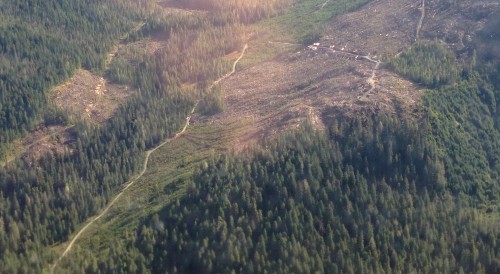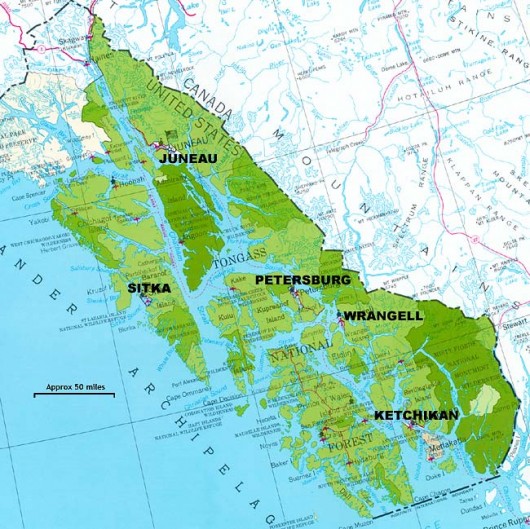The U.S. Forest Service moved forward Thursday with plans to transition to second-growth harvest on the Tongass National Forest within 16 years. The draft record of decision represents a compromise that won’t leave anyone completely happy.

Tongass Forest Supervisor Earl Stewart has chosen Alternative 5 for the proposed Tongass Land Management Plan amendment.
What does that mean? Well, there’s a lot of detail in the draft Record of Decision, but the main point is that during the transition, the U.S. Forest Service will offer an average of 46 million board feet of timber on the Tongass National Forest per year.
For the first decade, that will include more old-growth logging than second growth – almost three times as much. But then from years 11-15, the ratio will flip, allowing more young growth harvest and limiting old growth.
By year 16, timber stands offered for logging will be almost 100-percent young growth, with a few micro-sales of old growth for specialty products.
Concurrent with Stewart’s announcement was a flurry of news releases from various groups. Trout Unlimited Alaska likes the decision, because it protects more salmon streams; but various conservation groups are unhappy, and say that the transition should be faster.

On the timber industry side, Owen Graham of the Alaska Forest Association said the transition needs to slow down.
“We’ve always agreed that there needs to be a transition, but we wanted the trees to reach maturity, which is 30 years in the future,” Graham said. “If they cut the trees now, over the next 10-15 years, then they’ll be too small to be properly sawn in the sawmills, and they’ll just end up being exported to China.”
Graham said that the old-growth harvest planned during the transition isn’t adequate to maintain the few remaining sawmills. He added that a full inventory of young growth trees is needed before formalizing the amendment.
“To do this transition right now is purely politics and all the rubbish that people are making up that it’ll work; it’s all rubbish,” Graham said. “They know perfectly well that it won’t work and they don’t care.”
Dominick DellaSala, though, said it has worked in his state. He’s a scientist with the Geos Institute in Ashland, Ore., and also is unhappy with the draft Record of Decision. But his complaint is that the proposed transition is too slow, and will not do enough to combat climate change.
“I think the Forest Service is missing an opportunity here because they’re basing (their decision) on old-school forestry and antiquated log processing techniques,” DellaSala said.

DellaSala, who advocates for a transition within five years, said there are new technologies that will allow mills to operate profitably with young-growth trees. He said Good Faith Lumber on Prince of Wales Island tested that equipment, and it worked, which shows mills that are willing to adapt can survive a transition.
The Tongass plan amendment has been in the works for a few years, ever since Secretary of Agriculture Tom Visack directed the Forest Service to transition to young growth. Part of that process was the formation of the Tongass Advisory Committee, or TAC: a group of 15 representatives of Southeast conservation, tribal and timber industry groups.
Andrew Thoms of the Sitka Conservation Society was one of the TAC members, representing environmental interests.
“As a conservationist, I’d love to see the Forest Service get out of old growth right now, but our involvement in the advisory committee really followed this ethic of trying to come up with a collaborative solution and make Tongass management work for all the stakeholder groups,” Thoms said.
Thoms said Alternative 5 protects high-value habitat and provides a road-map for a full transition to young growth. He added that dissatisfaction on the part of some timber industry representatives and some conservation groups indicates that the decision is a true compromise.

There has been some concern by Alaska’s congressional delegation that the amendment is moving forward before a complete inventory of young growth is complete, and there is pending legislation to delay the transition. But Tongass Forest Supervisor Stewart said that isn’t an impediment.
He said the Forest Service considered hundreds of thousands of comments on the issue, along with the TAC recommendations and input from scientists.
“We believe we have enough information at this time to go forward with the forest plan amendment, yet concurrently we will continue with the inventory for more on-the-ground decisions,” Stewart said.
And if that inventory shows there isn’t adequate young growth to support the industry, Stewart said there is flexibility within the Tongass Land Management Plan to evolve.
You can read the draft Final Environmental Impact Statement and Record of Decision here. The link also provides information on how to comment.
A final Record of Decision is expected by the end of the year.




